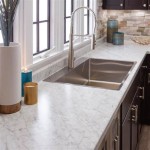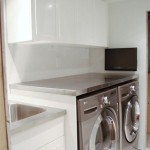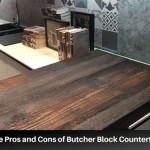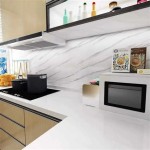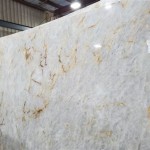How to Fabricate a Kitchen Countertop
Fabricating a kitchen countertop is a significant undertaking that requires careful planning, precise execution, and a thorough understanding of materials and techniques. This process involves selecting the appropriate material, accurately measuring the space, cutting the material to size, shaping the edges, and finishing the surface. The following details the general process and considerations for fabricating a kitchen countertop.
The initial stage is material selection. Common choices include granite, marble, quartz, butcher block, concrete, laminate, and stainless steel. Each material presents unique properties in terms of durability, aesthetics, cost, and ease of fabrication. Granite and marble offer natural beauty and durability, but require sealing and can be prone to staining. Quartz is a manufactured stone that is non-porous and highly resistant to scratches and stains. Butcher block provides a warm, natural look and is relatively easy to work with, but requires regular maintenance. Concrete allows for custom shapes and finishes, but can be heavy and requires sealing. Laminate is an affordable option that comes in a wide variety of colors and patterns, but is less durable than other materials. Stainless steel offers a sleek, modern look and is highly durable and hygienic, but can be susceptible to scratches.
Once the material is selected, precise measurements of the existing cabinetry or the designated countertop area are essential. Accurate measurements are paramount to ensure a seamless fit and prevent costly mistakes. It is recommended to create a detailed template of the countertop layout, accounting for any irregularities in the walls or cabinetry. This template can be created using cardboard, plywood, or specialized templating tools. The template should include cutouts for sinks, cooktops, and any other fixtures that will be integrated into the countertop.
The next step involves transferring the template to the chosen countertop material and cutting it to size. This process requires specialized tools and techniques, depending on the material. For stone materials such as granite, marble, and quartz, a wet saw with a diamond blade is typically used to ensure clean and accurate cuts. For wood materials such as butcher block, a circular saw or table saw can be used. Laminate can be cut with a utility knife or a saw with a fine-tooth blade. Concrete can be cast to the desired shape using molds. It is crucial to wear appropriate safety gear, including eye protection and respiratory protection, when cutting countertop materials.
After the countertop material is cut to size, the edges must be shaped and finished. This can be achieved using a variety of tools, such as routers, sanders, and polishing pads. The desired edge profile will influence the appropriate tools and techniques. Common edge profiles include bullnose, ogee, eased, and beveled edges. For stone materials, a wet polisher with diamond polishing pads is used to achieve a smooth, polished finish. For wood materials, sandpaper with varying grits is used to smooth the edges and prepare them for finishing. Laminate edges can be finished with edge banding, which is applied using an adhesive and trimmed to size.
The final stage involves finishing the countertop surface to protect it from stains, scratches, and other damage. This may include applying a sealant, stain, or other protective coating. For stone materials, a penetrating sealant is typically applied to prevent liquids from seeping into the pores of the stone. For wood materials, a sealant must also be applied to protect from moisture. Concrete countertops also benefit from a sealant to reduce staining.
Key Point 1: Material Selection and its Implications
The selection of the countertop material significantly impacts the overall aesthetic, durability, and maintenance requirements of the kitchen. Each material has inherent strengths and weaknesses that must be considered based on individual needs and preferences. Granite, for instance, offers a luxurious appearance and high heat resistance, but it can be heavy and requires regular sealing to prevent staining. Quartz, a manufactured stone, provides consistent color and pattern, along with resistance to scratches and stains, making it a more practical choice for high-traffic kitchens. Wood butcher block offers a warm and inviting aesthetic, but it is susceptible to water damage and requires consistent oiling and maintenance. Laminate offers a cost-effective and versatile option, however, it is not as durable.
The long-term implications of material selection should be carefully evaluated. For example, choosing a porous material like granite or marble necessitates a commitment to regular sealing to prevent stains from spills. Failure to maintain the sealant can result in permanent discoloration and damage. Conversely, selecting a non-porous material such as quartz or stainless steel reduces the need for ongoing maintenance, making it a more convenient choice for busy households.
Moreover, the ease of fabrication varies considerably depending on the material. While wood butcher block can be readily cut and shaped using standard woodworking tools, stone materials like granite and quartz require specialized equipment such as wet saws with diamond blades. The complexity of the fabrication process can influence the overall cost and timeline of the project, especially if professional installation is required. Therefore, it is essential to consider one's skill level and access to the necessary tools when selecting a countertop material.
Key Point 2: Precision in Measurement and Templating
Accurate measurements and templating are critical to ensuring a proper fit for the kitchen countertop. The process begins with taking precise measurements of the existing cabinetry or the designated countertop area. It is imperative to measure multiple points along the length and width of the space, accounting for any inconsistencies or irregularities in the walls or cabinetry. Walls are rarely perfectly square, and cabinets may not be perfectly aligned. These minor variations can accumulate and lead to significant discrepancies if not properly accounted for during the measurement process.
Creating a detailed template is highly recommended, particularly for complex countertop layouts with curved edges, angled corners, or integrated sinks and cooktops. The template serves as a precise representation of the countertop's shape and dimensions, allowing for accurate cutting and fabrication. The template can be made from various materials, including cardboard, plywood, or specialized templating tools. The chosen material should be rigid enough to maintain its shape during the templating process.
When templating, it is important to mark the locations of all fixtures that will be integrated into the countertop, such as sinks, cooktops, faucets, and soap dispensers. The cutouts for these fixtures must be precisely located and sized to ensure a seamless fit. It is also advisable to add a slight overhang to the countertop beyond the edge of the cabinets. This overhang provides a comfortable lip for sitting and prevents spills from running directly down the cabinet fronts. The overhang should be consistent around the perimeter of the countertop, typically ranging from 1 to 1.5 inches.
Key Point 3: Cutting, Edge Profiling, and Finishing Techniques
The cutting and shaping of the countertop material require specialized tools and techniques that vary depending on the material. For stone materials such as granite, marble, and quartz, a wet saw with a diamond blade is essential. The wet saw uses water to cool the blade and reduce dust, preventing chipping and cracking during the cutting process. The diamond blade is designed to cut through hard materials with precision. It is crucial to wear appropriate safety gear, including eye protection and respiratory protection, when operating a wet saw.
Edge profiling is the process of shaping the edges of the countertop to create a desired aesthetic. Common edge profiles include bullnose, ogee, eased, and beveled edges. A router with various router bits can be used to create these edge profiles. For stone materials, a wet polisher with diamond polishing pads is used to smooth and polish the edges after they have been routed. The polishing process involves multiple stages, starting with coarse pads and gradually progressing to finer pads to achieve a smooth, polished finish.
Finishing the countertop surface involves applying a sealant, stain, or other protective coating to protect it from stains, scratches, and other damage. For stone materials, a penetrating sealant is typically applied to prevent liquids from seeping into the pores of the stone. The sealant should be applied evenly and allowed to cure according to the manufacturer's instructions. For wood materials, a sealant such as polyurethane or varnish is applied to protect the wood from moisture and wear. Multiple coats of sealant may be required to achieve adequate protection.
Laminate countertops require a different finishing technique, typically involving edge banding. Edge banding is a thin strip of material that is applied to the exposed edges of the laminate countertop to conceal the particleboard core. The edge banding is applied using an adhesive and trimmed to size using a utility knife or a specialized edge banding trimmer. The edges should be sanded smooth to create a seamless transition between the laminate surface and the edge banding.
Properly fabricating a kitchen countertop requires a combination of technical skills, attention to detail, and a thorough understanding of the materials and techniques involved. While it is possible to fabricate a countertop as a DIY project, it is often recommended to seek professional assistance, especially when working with complex materials like stone or concrete. Professional countertop fabricators have the necessary expertise, tools, and equipment to ensure a high-quality finished product. Professional fabrication is important, especially when a warranty is required.

How To Build Countertops Simple Step By Guide Youtube

Building Diy Wood Countertops From Plywood Laminate For 300 Crafted Work

How To Make A Diy Wood Countertop H2obungalow

How To Build A Wood Countertop

How To Make A Diy Wood Countertop Easier Than You Thought Artsy Chicks Rule

How To Make Your Own Faux Marble Countertops From Plywood And Save Thousands Youtube

How To Make A Diy Wood Countertop Easier Than You Thought Artsy Chicks Rule

Affordable Diy Countertops That Will Blow Your Mind

Building Diy Plywood Countertops Rocky Hedge Farm

How To Make A Concrete Countertop For Your Kitchen Or Garage Work Diy Step By
See Also


